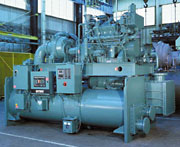
For areas with “relatively high cooling season electric costs and relatively low cooling season gas costs,” or where “electric availability is an issue,” natural gas cooling offers a viable alternative, says Bill Stewart, product manager, gas engine and steam turbine-driven centrifugal chillers, York Inter-national Corp., York, PA. And its use is growing in selected markets such as New York, the Northeast, and the West Coast.
Gas cooling includes absorption chillers (single-stage steam, two-stage steam, and direct-fired), natural gas engine-driven chillers, and steam turbine-driven chillers. Typical natural gas engine-driven chiller sizes range from 5 up to 5,000 tons. Steam turbine-driven chiller sizes range from 400 to 5,000 tons.
Stewart says that gas cooling has been applied in hospitals, universities, government facilities, and large central cooling plants, as well as some smaller operations. In areas where electric distribution may be a problem, such as the difficulties in California, gas cooling can offer a more reliable option.
Gas chillers, especially engine-driven chillers, also “produce less pollution when you evaluate it at the source,” notes Stewart.
Some companies are now installing both gas and electric chillers to ensure availability and take advantage of the lowest cost resource. “A hybrid chiller plant is the best way to go,” Stewart says, “because it enables the plant operator to switch to whatever energy source makes sense at that time. We even have seen chiller plants migrate to a tri-fuel source operation µ electric motor, natural gas engine, and steam turbine drive chillers µ all in one facility. They have double redundancy on their energy source, and effectively compete all three sources for the lowest operating costs.”
DOD Gases Up
In an effort to reduce the cost and the environmental impact of operating air conditioning systems at Department of Defense (DOD) installations, the U.S. Army Construction Engineering Research Laboratories (USACERL) and the Naval Facilities Engineering Service Center (NFESC) evaluated the application of natural gas cooling.Hospitals, barracks, and other facilities where large cooling and hot water loads exist were determined to be prime candidates for gas cooling technologies. Funding for this program was split equally between the Army, Air Force, and Navy.
Implementation sites were identified and projects were undertaken to assess the switch from electric to gas cooling, and determine its overall applicability for DOD facilities. A number of sites were identified where gas cooling could be considered for replacement of existing failed or failing chillers. These sites were technically feasible, economically attractive, and within the budget provided by Congress.
The DOD-wide analysis identified 1,340 potential applications for gas chillers. The financial results of the analysis indicated approximately $212 million in savings could be achieved by implementing gas cooling for an initial investment of about $89 million. The average simple payback was 5.6 years (see Table 1).
The source energy savings provided by gas cooling were calculated to be 3.3 million MBtu/yr. With a site gas increase of 2.5 million MBtu/yr, gas cooling provides net energy savings of about 0.8 million MBtu/yr.
Looking at pollution abatement, gas cooling reduces emissions at the generating station although it increases emissions somewhat at the installation site. From a net perspective, a gas system almost always decreases the generation of airborne pollutants. The exception is CO, and the increase determined was small (see Table 2).
As the above figures demonstrate, DOD’s analysis found that gas cooling can significantly reduce energy costs at military installations. In addition, it reduces the environmental impact of air conditioning as well.
Publication date: 01/29/2001




